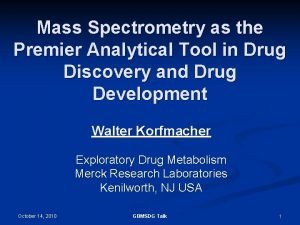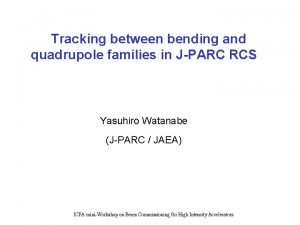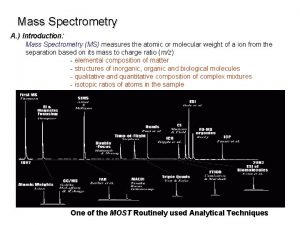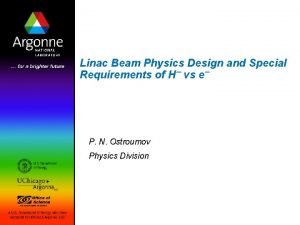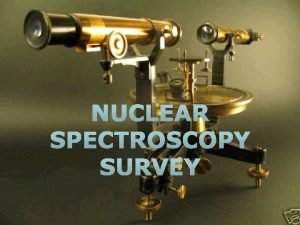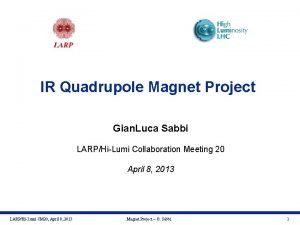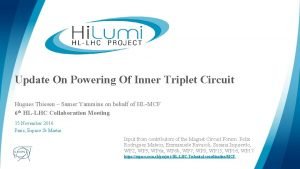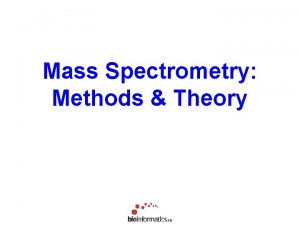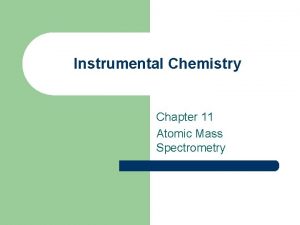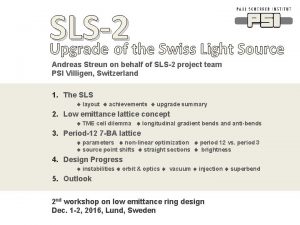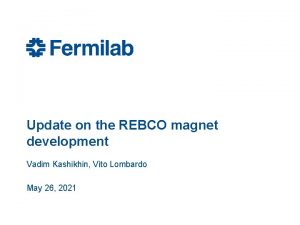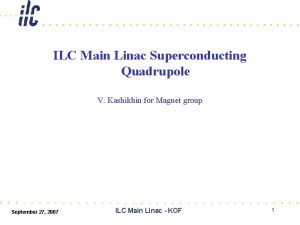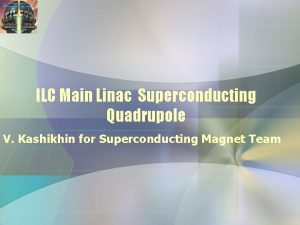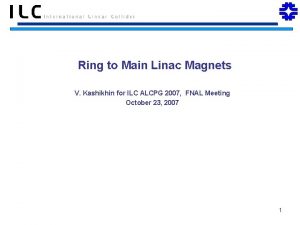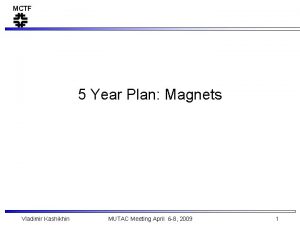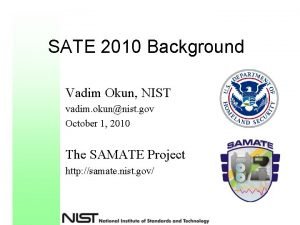Quadrupole magnets for the FCC triplets Vadim Kashikhin









- Slides: 9

Quadrupole magnets for the FCC triplets Vadim Kashikhin FCC Week 2018 11 April 2018

IRQ magnet requirements (from D. Schoerling) • • 2 Magnet Number Strength Length Aperture Q 1 low lumi 4/IP 270 T/m 10. 0 m 64 mm Q 2 low lumi 4/IP 270 T/m 15. 0 m 64 mm Q 3 low lumi 4/IP 270 T/m 10. 0 m 64 mm Q 1 high lumi 4/IP 130 T/m 14. 3 m 164 mm Q 2 high lumi 8/IP 105 T/m 12. 5 m 210 mm Q 3 high lumi 4/IP 105 T/m 14. 3 m 210 mm 6 magnet types and 3 distinct coil cross-sections: LL-Q 1/Q 2/Q 3, HL-Q 1, HL-Q 2/Q 3. Cable Jc specified for FCC dipoles (next slide). Operating temperature 1. 9 K. Nominal current < 20 k. A. 4/11/2018 V. V. Kashikhin | Quadrupole magnets for the FCC triplets

Cable parameters Parameter Strand diameter Specified in Euro. Cir. Col-P 1 -WP 5 Unit LL HL mm 0. 800 1. 000 Cu/non. Cu ratio Target virgin strand Jc(16 T, 1. 9 K)=2300 A/mm 2 1. 13 Number of strands 28 Bare cable width mm 12. 38 15. 10 Bare cable mid-thickness mm 1. 495 1. 869 Insulation thickness per side mm 3% cabling degradation included in this plot 0. 15 • A general consideration is that a bigger strand is better from the viewpoint of a magnet design. For a fixed coil thickness and number of layers (determined by the aperture and the required gradient) a bigger strand means: – – – a lower number of turns (fabrication labor) and a lower inductance (quench temperature); a more efficient design (fraction of superconductor is higher for the same insulation thickness); but a higher current (current leads start to be a problem at some point). • 1 mm strand is at about the sweet spot for the HL designs. Also the cable dimensions are similar to what is presently used for the 15 -16 T dipoles developed within the US MDP program and for the past 12 T HFDA models fabricated and tested at FNAL – a lot of practical experience with this kind of cable. • Strand diameter has to be reduced to 0. 8 mm for the LL designs to meet the maximum current requirement. 3 4/11/2018 V. V. Kashikhin | Quadrupole magnets for the FCC triplets

Coil designs and the geometrical field quality LL-Q 1/Q 2/Q 3 Unit LL-Q 1/Q 2/Q 3 HL-Q 1 HL-Q 2/Q 3 Aperture mm 64 164 210 Rref mm 21 55 70 0. 0003 0. 0032 0. 0002 -0. 0017 0. 0165 0. 0020 -0. 0811 0. 9223 0. 1117 b 10 b 14 4/11/2018 HL-Q 2/Q 3 Parameter b 6 4 HL-Q 1 10 -4 V. V. Kashikhin | Quadrupole magnets for the FCC triplets

Coil fields at SSL (1. 9 K) LL-Q 1/Q 2/Q 3 380 T/m HL-Q 1 167 T/m • • HL-Q 2/Q 3 131 T/m Two-layer coils meet the nominal gradient requirements with sufficient margins. One spacer/octant in the inner layer – sufficient for the field quality. Full cable keystoning in the outer layers of the HL designs. The coil peak field in LL design is 14 T: – a hybrid design with Nb. Ti conductor in the outer layer is possible. • The peak coil field in HL designs is 16 T - requires Nb 3 Sn in all the layers. 5 4/11/2018 V. V. Kashikhin | Quadrupole magnets for the FCC triplets

Iron yoke (fields at the nominal gradients) LL-Q 1/Q 2/Q 3 HL-Q 1 OD = 700 mm OD = 350 mm HL-Q 2/Q 3 OD = 900 mm • General constraints: – Yoke OD < 1 m (FCC requirement); – Peak field at the yoke outer surface < 2 T (at the nominal gradient) to minimize the fringe fields. 6 4/11/2018 V. V. Kashikhin | Quadrupole magnets for the FCC triplets

Magnet parameters Parameter Unit LL-Q 1/Q 2/Q 3 HL-Q 1 HL-Q 2/Q 3 Aperture mm 64 164 210 Iron yoke OD mm 350 700 900 Nominal gradient, Gnom T/m 270 130 105 Maximum gradient (SSL at 1. 9 K), Gmax T/m 380 167 131 0. 78 0. 80 Fraction of SSL at Gnom 7 Peak coil field at Gnom/Gmax T 9. 9/13. 9 12. 4/16. 0 12. 9/16. 1 Current at Gnom/Gmax k. A 15. 2/21. 9 17. 7/23. 4 17. 7/22. 7 Inductance at Gnom/Gmax m. H/m 1. 89/1. 83 8. 77/8. 44 13. 60/13. 14 Stored energy at Gnom/Gmax MJ/m 0. 22/0. 44 1. 37/2. 31 2. 13/3. 39 Fx per octant at Gnom/Gmax MN/m 0. 99/1. 86 2. 94/4. 62 3. 71/5. 55 Fy per octant at Gnom/Gmax MN/m -1. 22/-2. 49 -3. 55/-6. 04 -4. 48/-7. 18 Azimuthal midplane stress in IL at Gnom/Gmax MPa 65/97 138/233 185/295 Azimuthal midplane stress in OL at Gnom/Gmax MPa 49/131 135/225 159/251 4/11/2018 V. V. Kashikhin | Quadrupole magnets for the FCC triplets

Comparison to other magnets LARP/HL-LHC quadrupole: • 150 mm aperture • 133 T/m nominal gradient • 150 T/m tested LHC MQXB(A) quads: • 70 mm aperture • 215 T/m nominal • 230 T/m tested • Gnom/Gtest 0. 93 Technical challenge Nb. Ti option for LL: • Aperture 70 mm → 64 mm • Gradient 230 T/m → 252 T/m • Jc(5 T, 4. 2 K) 2750 A/mm 2 → 3300 A/mm 2 • Gradient 252 T/m → 302 T/m LL-Q 1/Q 2/Q 3 • Gnom/Gtest 0. 9 8 4/11/2018 HL-Q 1 Same gradient as in the HLLHC quad, 10% larger bore V. V. Kashikhin | Quadrupole magnets for the FCC triplets HL-Q 2/Q 3

Summary • The LL magnet requirements are within reach of the Nb. Ti technology. With the best available Nb. Ti strand, it becomes a feasible (and the most cost-effective) option. In case of the Nb 3 Sn design (or a hybrid Nb 3 Sn/Nb. Ti), it is possible to increase the nominal gradient by 10 -20% and to proportionally reduce the magnetic length. • The HL-Q 1 magnet parameters are at the present limit of the Nb 3 Sn technology. Slightly more challenging than 150 mm HL-LHC quadrupoles. The design feasibility has to be proven by the conductor and the magnet R&D campaigns, which can largely benefit from the LARP/HL-LHC experience. • The HL-Q 2/Q 3 parameters are very challenging. A substantial R&D is required to prove the feasibility: – Azimuthal stress is over the acceptable limit already at the nominal gradient. The equivalent stress would be even higher. Stress management is necessary. A 4 -layer design may be needed because of the reduced efficiency due to the internal support structure. Alternatively, using of the more strain-tolerant materials (Nb 3 Al) can be considered, but because of the lower critical current density the number of layers would also go up. – The stored energy is an order of magnitude higher than for the LL magnets. For Q 3, the total stored energy is over 30 MJ at the nominal gradient. The quench protection needs to be carefully studied. 9 4/11/2018 V. V. Kashikhin | Quadrupole magnets for the FCC triplets
